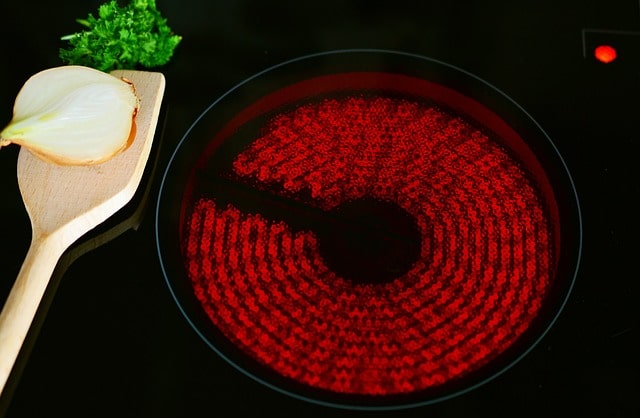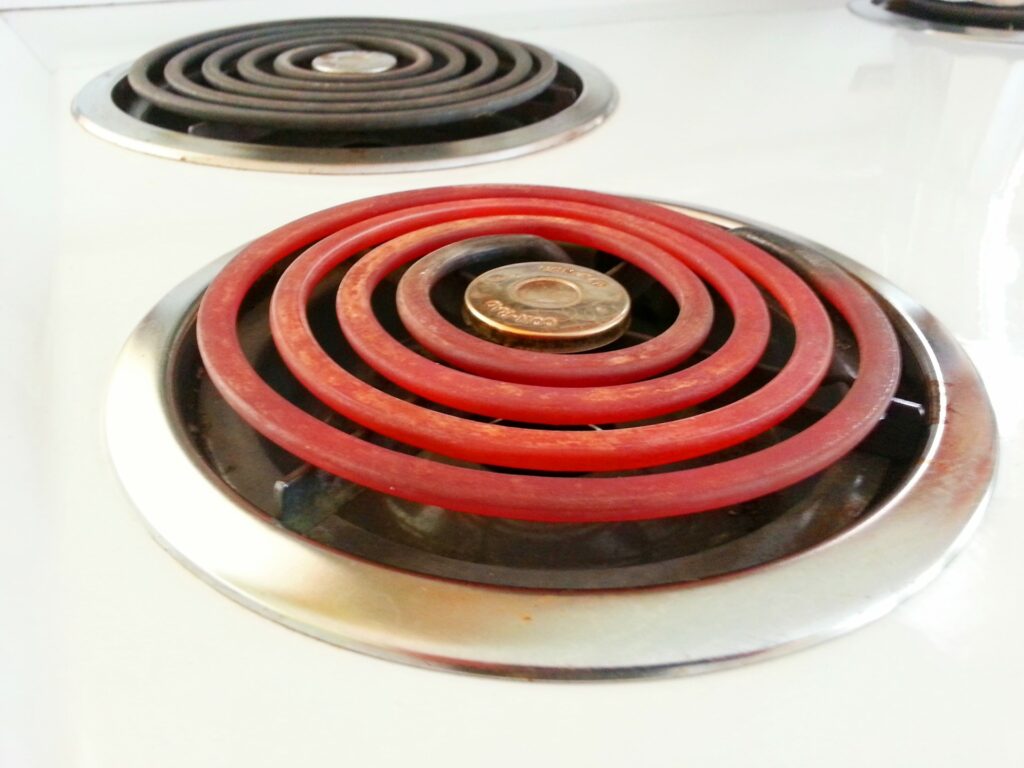Introduction – Cooking by Induction
An energy-efficient induction cooktop uses electromagnetic energy to heat your cookware rather than conductive heating via a surface or flame. This avoids the generation of a flame and allows for faster and more precise cooking. In comparison, traditional gas or electric stovetops generate heat that can be difficult to focus and results in heat loss.

Trend Is That Electric Cooking Will Increase In Carbon Efficiency
Efficiencies is what we aim for here at ShrinkThatFootprint, as that’s one of the ways to reduce carbon emissions consistently. When we cook, whether by natural gas or electrical stove top, there are carbon emissions for sure. In the former, burning of natural gas gives rise to carbon dioxide by-products, and in the latter, electrical generation relies on a mix of fossil fuels so therefore every kilowatt hour is associated with some amount of CO2 release. Only in certain countries like the Nordic region and countries with great hydropower like Brazil is the electricity to be very free of carbon emissions.
That being said, from our prior analysis, electric cooking technologies like heating coils and inductive cookers will become increasingly attractive for reducing carbon emissions because the trend of the electric grid fuel sources all over the world is toward renewables and therefore less carbon emissions.
How Energy Efficient Are Induction Cooktops Compared To Other Cooking Methods?
An induction cooktop cooks food by directly inducing an electric current in a metal pan or pot. This allows the cooktop to heat up quickly and precisely, making it an energy-efficient option compared to traditional stove tops that use gas or electricity to generate heat. Additionally, induction cooktops are more durable than other cooktops since they do not require exposed heating elements that you can easily damage.
Regular electric stove tops pass electricity through a “heating element” inside a metallic coil. The coil does nothing with the electricity except acquire heat via the transfer of electrical energy. The heating element grows hot. The end-to-end efficiency of a heating element transferring energy to your pot is 75%-80%.

In contrast, an inductive cooker uses electricity to generate a magnetic field that accelerates the electrons in the cookware directly. The movement of electrons heats up the cookware. There’s no intermediary heating element to transfer the energy. This process is 85% efficient.
Therefore, there’s a 5%-10% efficiency gain from the inductive cooker. Induction cooktops use electromagnetic energy to heat the cooking vessel directly, while gas and electric cooktops rely on heating coils or burners. This means that an induction cooktop loses less energy during the cooking process.
| Efficiency | |
| Traditional electric stove with coils | 75%-80% |
| Inductive cooker | 85% |
Further enhancing their efficiency, induction cooktops generate heat directly in the cookware. This minimizes heat loss to the surrounding air, which in turn reduces the burden on HVAC equipment. This unique attribute not only enhances energy efficiency but also enhances safety, as the cooking top surface remains cool to the touch.
Studies have shown that induction cooktops also reach cooking temperatures 20-50% faster than gas or electric. Additionally, because the surface of an induction cooktop remains cool to the touch, there is less risk of accidental energy waste from leaving a burner on for too long.
So not only do they significantly reduce cooking time, but induction cooktops also save energy in the long run. It’s clear why so many restaurants and professional chefs are switching to induction – it’s a win-win for both flavor and efficiency.
The induction cooktop is also safer to use because the cooking surface remains cool to the touch. Cleanup is a breeze as spilled food will not burn onto the surface. So not only can an energy-efficient induction cooktop save energy and make cooking easier, but it can also improve kitchen safety.
How Does An Energy-Efficient Induction Cooktop Work?
An energy-efficient induction cooktop utilizes magnetic fields to heat pots and pans. When a pot or pan is placed on the cooktop, an electric current passes through coils beneath the surface, producing a strong magnetic field. This magnetic field causes the molecules in the metal pot or pan to vibrate rapidly, creating resistance and generating heat.
This allows the cooktop to quickly and efficiently reach high temperatures while also staying cool to the touch. Additionally, because only the pot or pan is heated, less energy is wasted as opposed to traditional cooking methods that heat the whole stove surface. This makes induction cooking not only more efficient but also safer for kitchens.
How Much Do Induction Cooktops Cost Compared To Other Cooking Methods?
Induction cooktops are a popular and efficient option for cooking, but how do they stack up in terms of cost compared to traditional stovetops and gas ranges? Generally speaking, induction cooktops are initially more expensive, ranging from $800 to $2,000 for the cooktop itself.
However, this cost is offset by their energy efficiency, as induction cooktops use up to 90% of the generated heat for cooking rather than wasting it like gas or electric stovetops. In the long run, this results in significant savings on electricity bills. Additionally, induction cooktops often have a longer lifespan than gas ranges and require less maintenance. Overall, while initial costs may be higher, the long-term savings and convenience make investing in an induction cooktop a smart choice.
Things To Consider Before Buying An Energy-Efficient Induction Cooktop
Energy-efficient induction cooktops offer many benefits, but before making a purchase, it’s important to consider a few key factors. First and foremost, choosing an induction cooktop compatible with your existing pots and pans is important. Some older pots or pans may not work well on induction surfaces, so check the compatibility of any new cooktops you’re considering.
While induction cooktops offer significant energy savings, they can also be more expensive than other options in the initial purchase price. Additionally, you should consider installation costs if your kitchen setup does not allow easy insertion or connections.
Ultimately, whether an induction cooktop is right for you will depend on various factors, such as budget and cooking style. But if you’re looking for an efficient, high-performing cooking option that saves money over time, it’s hard to beat the benefits of induction cooktops.

What Are Some Tips For Using An Induction Cooktop Safely And Efficiently?
To ensure the safe and efficient use of your induction cooktop, make sure to use cookware compatible with inductive heating. This means using flat-bottomed pots and pans made from iron or stainless steel.
Avoid aluminum or glass cookware, as they will not work on an induction cooktop. Keeping the cooktop clean is also important, as debris and excess moisture can interfere with heat transfer. And while an induction cooktop heats up quickly, always use caution when touching the surface – it may not feel hot to the touch, but the transferred heat can still burn you.
To save energy, consider using a pot or pan that closely matches the size of the heating element, as this maximizes heat transfer and cuts down on prep and cooking time. By following these tips, you can enjoy all the speed and convenience of an induction cooktop while ensuring safe and efficient use.
Do Energy-Efficient Induction Cooktops Work?
The short answer to this question is that energy-efficient induction cooktops work. But why switch to induction cooking in the first place? Traditional gas and electric stovetops radiate heat absorbed by any pots or pans on their surface. On the other hand, induction cooktops use magnetic fields to directly transfer heat to induction-compatible cookware.
This means less wasted energy and less heat transfer to the surrounding air, leading to more efficient cooking. Induction cooking also offers greater temperature control and the ability to turn off the heat instantly, greatly reducing the risk of burning food or causing kitchen accidents.
So, an induction cooktop may be worth considering for those looking for a more efficient cooking option. And don’t worry – plenty of affordable induction-compatible cookware options are available on the market now. Just make sure your cookware has a magnet sticking to it before making the switch!
Summary
In conclusion, energy-efficient induction cooktops are a great option for those looking to save time and money while enjoying high-performance cooking. With careful planning and attention to safety, you can easily take advantage of the benefits of induction cooking on your kitchen counter. Good luck!
